22. CHARADES (Discussion)
Description: Charades is a pantomime game in which players act out a word or phrase with body language and gestures.
Application: Use charades as a warm-up or review of previously learned material.
Process: Have an overall topic in mind when planning to use charades. Create charade cards, one charade per card and enough cards for each student to play. Divide cards into two piles and place in basket(s) so that students cannot see the cards before they make their selection. Split students into two teams and announce which team goes first and that each turn will last a certain determined amount of time, such as two minutes. Review the procedure with students: 1) During charades there will be no audible signals from the player who is acting out the charade; 2) A player from a team will pick a charade card from the basket and act out the clue; 3) If the team correctly identifies the clue within the time limit, it gets a point and the other team goes next; 4) If the team does not answer or answers incorrectly, the opposing team gets one attempt to answer; 5) If the opposing team is correct, the point goes to them and they will then select from the basket and the process continues; and 6) If they answer incorrectly, they will just select from the basket and the game continues; no points will be deducted. Before the game begins, hand out the Charades Clue sheet (Addendum GG) to help students give meaningful clues to their teammates. After the entire game has been played, add total points from each team and as a final task, ask each team to write on an index card what the topic was of the charades game. Award five additional points to either or both teams if they correctly answer the topic question and announce the winner.
Description: Charades is a pantomime game in which players act out a word or phrase with body language and gestures.
Application: Use charades as a warm-up or review of previously learned material.
Process: Have an overall topic in mind when planning to use charades. Create charade cards, one charade per card and enough cards for each student to play. Divide cards into two piles and place in basket(s) so that students cannot see the cards before they make their selection. Split students into two teams and announce which team goes first and that each turn will last a certain determined amount of time, such as two minutes. Review the procedure with students: 1) During charades there will be no audible signals from the player who is acting out the charade; 2) A player from a team will pick a charade card from the basket and act out the clue; 3) If the team correctly identifies the clue within the time limit, it gets a point and the other team goes next; 4) If the team does not answer or answers incorrectly, the opposing team gets one attempt to answer; 5) If the opposing team is correct, the point goes to them and they will then select from the basket and the process continues; and 6) If they answer incorrectly, they will just select from the basket and the game continues; no points will be deducted. Before the game begins, hand out the Charades Clue sheet (Addendum GG) to help students give meaningful clues to their teammates. After the entire game has been played, add total points from each team and as a final task, ask each team to write on an index card what the topic was of the charades game. Award five additional points to either or both teams if they correctly answer the topic question and announce the winner.
Reference and/or for more information:
22. Charades
http://www.wikihow.com/Play-Charades
http://www.fun-stuff-to-do.com/charade-clues.html
22. Charades
http://www.wikihow.com/Play-Charades
http://www.fun-stuff-to-do.com/charade-clues.html

